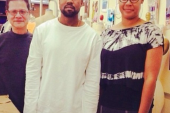

On Monday, Juma showed its Spring/Summer ’12 collection inside the tents at David Pecaut Square. Within 24 hours, The Peacock Parade (TPP)—a three-month-old Canadian flash sale site—had broadcasted the show on its website. Members of the invite-only website could shop Juma’s collection immediately. And the process will be repeated with Denis Gagnon’s grand closing show on Friday night. In other words: no more six-month rule. You see it, you love it, you buy it.
Called “Off the Runway,” the new venture bookending LGFW is the work of TPP founders Jan Gandhi and Nancy Sahota—entrepreneurs inspired by both the pioneering creative head of Burberry, Christopher Bailey, and their project’s American forerunner, Moda Operandi.
Gandhi and Sahota chose Juma and Denis Gagnon, wanting designers who had different aesthetics but were relatively well-known in Canada: Toronto cool kids Juma have collaborated with Harvey Nicholls and designed for Nicki Minaj, while Montreal’s Denis Gagnon has his own pack of steadfast admirers. “Off the Runway” gives these designers a way to connect directly with said fans: no buyers in-between, nothing edited or “curated” by the fashion elitists. Instead, designers select pieces for which they can fill orders and work with TPP on price points.
But Gandi and Sahota are quick to point out they’re not replacing boutiques. “The intention isn’t to cut out the brick and mortar or the middleman,” says Sarota. “It’s to create an awareness of these great Canadian designers on a national level.”
For designers like Juma, it’s about finding out what the customer wants. “For us, it’s a big experiment and also a good research project,” says Jamil Juma, one half of the sibling design duo. “Currently, we show our line to buyers. But this time, it will be open to thousands of customers and their feedback is pretty valuable to us.”
In February, Aslaug Magnusdottir and Lauren Santo Domingo launched Moda Operandi, a US-based site that allowing the fashion-starved to pre-order runway collections within 48 hours of showing (their tagline rings of a politician’s campaign promise: “tomorrow’s fashion today”). Not long after, Style.com followed in those well-heeled footsteps, working with e-commerce partner Edition01 to bring the spring 2012 collections of six NYFW designers to customers straightaway. But it was Christopher Bailey who trailblazed the retail concept two years ago, and on a much larger scale, when he introduced “Runway to Reality.” With nary a precedent, key pieces of Burberry’s fall 2010 women’s collection were for sale online fresh off the runway.
So while this consumer-catwalk dalliance isn’t new, it’s new to Canada. Here, fashion design tends to be a seasonal afterthought, embraced twice a year during fashion week and forgotten in the months between.
Part of it’s that Canadians don’t necessarily have access to homegrown labels. If they shop online, as many of us do, it’s not from websites offering Canadian wares (this is changing as The Bay intros net-shopping, for one). We’re less exposed to Canadian fashion and consequently, less aware of Canadian designers. E-commerce is one way to potentially address this. Hence, TPP.
It’s not an easy sell to our designers, though. The idea challenges the production system in the fashion industry, which has traditionally worked six months ahead. How, exactly, will designers condense their production cycles by two-thirds? According to Gandhi and Sahota, the two-month waiting time gives them enough time to fill orders, but still makes sure customers have the pieces they covet well before they hit the racks. For Jamil of Juma, there’s pressure to make that turnover, but that’s the way it should be, he says.
But what about us? What about the fashion diehard’s feverish wait, the excitement that mounts over those traditional six months? Gandhi and Sahota see it differently. Canadian designers should capitalize directly from the hype built on the LGFW runways, before they’re forgotten, as too often—in a country where fashion’s not a priority—they are.
“It’s top of mind,” says Sahota. “You see it on the runway, you love what you see, but now you have to wait months and months to buy it.”
“Personally, I think there’s a big disconnect in fashion right now,” says Jamil. “The traditional runway as it was maybe ten years ago may not be relevant right now. Unfortunately, the industry is still working in that pattern. If I was in charge, I’d be showing fall runway right now. There’s a much bigger audience of consumers now who’re seeing it right away. Why are we showing what they can’t have?”
And what consumers could have is this: easily accessible clothes from the runway that work in tandem with the seasons. But for now, they’re being romanced by an LGFW spring that seems far away and might soon be forgotten in the dreary stretch of winter.














